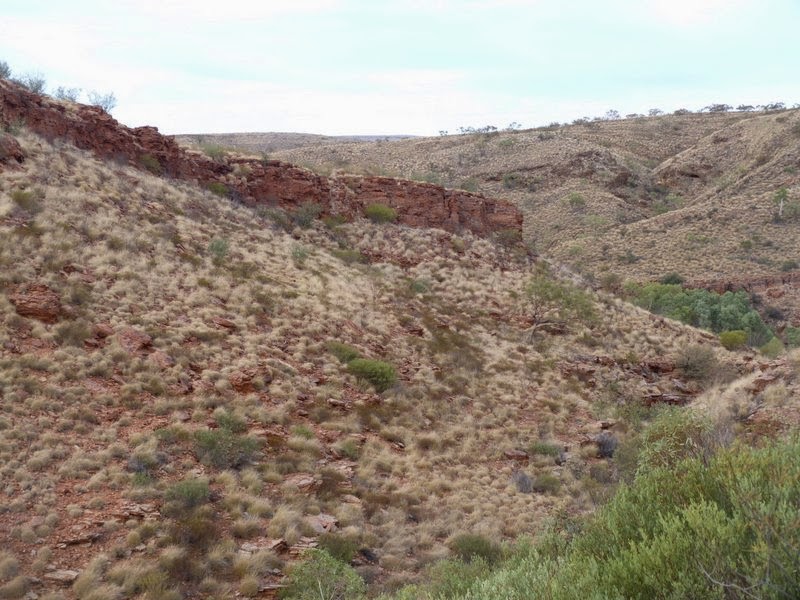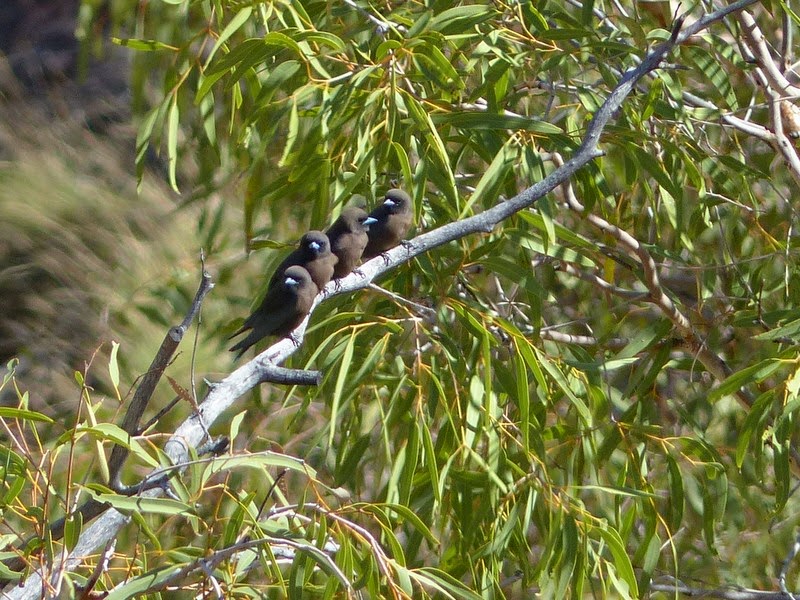I had the privilege of redoing one of my favourite walks recently, during our trip to central Australia. Ormiston Pound and Gorge walk is one of the most spectacular half-day circuits in the entire country, and readily accessible to most people - unlike some other red centre walks it is reached by bitumen road, and the 7km walk itself is well within the capacity of anyone moderately fit person.
It's 130km west of Alice Springs along Larapinta and Namatjira Drives, involving a drive along the southern face of the superb West MacDonnell Ranges. You can do it as a day trip from The Alice but the drive itself warrants a day of your time, and you can either camp at the start of the walk (in the Parks Service camp ground) or stay in basic units at nearby Glen Helen Resort (don't think of planted palm trees and waiters - it's actually quite nice!).
 |
| Typical roadside panorama of the West MacDonnells from Larapinta Drive, en route to Ormiston. |
The circuit walk starts in the (mostly dry) bed of Ormiston Creek, and begins with a steady but well-graded climb to a spectacular lookout over the Ormiston Pound, a broad sandy plain ringed with sandstone hills. It descends to the pound and crosses it through open woodland and spiky hummock spinifex grass, before entering Ormiston Gorge and returning to the start with some rock-hopping, depending on the water level. This was the fifth time I've done the walk, and the only time the gorge has actually been closed because of high water; on each other occasion I've avoided even getting wet feet.
The gullies in particular - which the path follows and crosses - support a variety of plant and associated animal life.
 |
| Curry Wattle Acacia spondylophylla (above) really smells wonderfully of curry spices; it and Red Wattle A. monticola (below) thrive on the exposed rocky slopes. |
 |
| Native Cotton Gossypium australe family Malvaceae; a true cotton. |
 |
| Grey-headed Honeyeater Lichenostomus keartlandion Corkwood Hakea lorea. |
 |
| Panther Skink Ctenotus pantherinus.This robust skink was hunting insects while staying close to the safety of the spinifex clump. |
After all this excitement - and the climb - the short detour up a narrow ridge to sit and look out over the panoramic pound is very welcome.
 |
| Ormiston Pound, ringed by the rugged folded sandstone hills of the West MacDonnells, above and below. |
 |
| The view back to lovely Mount Sonder, made famous by sublime Arrernte artist Albert Namatjira, is pretty splendid too. |
From here we descend to the open plains, passing through spinifex and low rocky ridges.
 |
| Sharp-capped Mallee Eucalyptus oxymitra in spinifex grassland. 'Mallee' is a term for multi-stemmed shrub-form eucalypts found in drier low soil nutrient situations. |
Finally we enter the deep shady gorge, with tumbled boulders on the sandy creek bed. It is a truly beautiful section of the walk- and the shelter is welcome on a hot or windy day.
 |
| Ormiston Gorge; the trees in the creek bed are River Red Gums Eucalyptus camaldulensis,which have managed to establish themselves despite infrequent but severe floods. |
 |
| Determined River Red Gum seedlings. |
The tumbled boulders in the bed are comprised of purple quartzite, formed from sandstone under immense pressures, often those associated with orogeny - mountain building.
 |
| I'm no geologist, but I find these exquisite. |
Up on the rock walls are plants clinging to life but above the floodwaters.
 |
| Variable Daisy Brachycome ciliaris. |
 |
| Ghost Gum Eucalyptus aparrerinja. These are wonderful trees at any time; this one is truly extraordinary and I have not tilted the camera! |
 |
| Towards the end of the gorge pools appear, deep and cold. If you're lucky you'll be able to walk around them - mostly you can. |
These of course attract life and species not seen elsewhere on the walk.
 |
| Little Pied Cormorant Microcarbo melanoleucos. One of the world's smallest cormorants, found anywhere in inland Australia. |
 |
| Scarlet Percher Diplacodus haematodus; I am always delighted to find dragonflies in the far inland (and indeed anywhere!). |
 |
| Blue Skimmer Orthetrum caledonicum |
Shortly after these pools we meet people pottering along for a short walk from the carpark - we feel a bit sorry for them, and what they've missed - and a nice formed path. It means lunch and shelters and seats are near to hand, but it's not quite the same as where we've been, with the butcherbirds fluting from the cliffs and emphasising silence, and the colours of rock, tree trunk and sky.
But please, don't just take my word for it....
BACK ON SUNDAY, TO CELEBRATE ANOTHER ANNIVERSARY












No comments:
Post a Comment